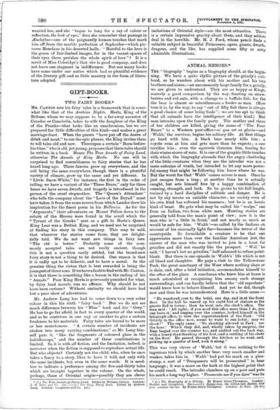GIFT-BOOKS.
TWO FAIRY BOOKS.*
Ma. CA.NTON sets his fairy tales in a framework that is some- what like that of the Arabian Nights. Herla, King of the Britons, whom we may suppose to be a far-away ancestor of Caradoc or Canobelin, takes to wife the daughter of the King of the Franks—that looks like an anachronism, but we are prepared for little difficulties of this kind—and makes a great marriage-feast. When the guests "have put off the desire of drink and meat," to use the epic phrase, the King invites them to tell tales old and new. Thereupon a certain " Born-before- his-time," who is old, yet young, proposes that these tales should be written in a book. Hence The True Annals of Fairy Land, otherwise The Annals of King Herla. No one will be surprised to find resemblances to fairy stories that he has heard long ago. These fancies grow up- everywhere, and the soil "being the same everywhere, though -there is a plentiful variety of climate, grow up the same and yet different. In "Little Snow-White," for instance, the first in the order of telling, we have a variant of the "Three Bears," only for three bears we have seven dwarfs, and tragedy is introduced in the person of the cruel stepmother. The "Queen's Attendant" who tells the company about the "Love of the Dryad" must have taken it from the same source from which Landor drew his inspiration for the finest poem in his Hellenies. As for the ".Argonauts," their adventures on Mount Pelion down to the retinii of the Heroes were foiind in the scroll which the
Tyrant of the Greeks" sent as a gift to Herla's Queen King Lear was a British King, and we need not be surprised at finding his story in this company. This may be said, that wherever the stories come from, they are delight- fully told. We do not want new things in fairy lore. "The old is better." Probably some of the com- monly accepted tales are not really ancient, though this is not a question easily settled, but the brand-new fairy story is not a thing to be desired. One reason is that it is sadly apt to be didactic, and to have a moral. In the genuine thing the virtue that is best rewarded is being the youngest of three sons. If we have a fault to find with Mr. Canton, it is that there is something like a lesson in the ending of his "Annals." Poor King Herla is grievously punished for what, by fairy land morals, was no offence. Why should he not have been curious ? Without curiosity we should have had but a poor show of adventures.
Mr. Andrew Lang has had to come down to a very sober colour in this his sixth "fairy book." But we do not see much difference between his " Blue " book and his "Grey." He has to go far afield, in fact to every quarter of the world, and so he contrives in one way or another to give a certain freshness to his materials. Fairy tales are bound to be more or less monotonous. "A certain number of incidents are shaken into many varying combinations," as Mr. Lang him- self puts it, "like the fragments of coloured glass in the kaleidoscope," and the number of these combinations is limited. So it is with all fiction, and the limitation, indeed, is narrower when the fiction is supposed to reproduce actual life. But who objects? Certainly not the child, who, when he once takes a fancy to a story, likes to have it told, not only with the 'same incidents, but even in the same words. It is need- less to indicate a preference among the five-and-thirty tales which are brought together in the volume. On the whole, perhaps, those of Oriental origin—possibly they are clever
• .(I.) The True Annals of Fairy Land. Edited by William Canton. London: J. M. Dent and Co. (es.)—(2.) The Grey Fain/ Book. Edited by Andrew Lang. London: Longumus and Co. lee.]
imitations of Oriental style—are the most attractive. There is a certain impressive gravity about them, and they seldom deal in the horrible. Mr. H. J. Ford, whose pencil finds a suitable subject in beautiful Princesses, ogres, giants, dwarfs, dragons, and the like, has supplied some fifty or sixty admirable illustrations.






















































 Previous page
Previous page